|
|
|
 |
|
Download the article as an Acrobat pdf - get the
article
here, get Acrobat
here - free |
|
 |
| |
|
|
Putting Pruning Into Context
Published in essentialARB issue 9 (Summer 2003)
Words & Photography: Andrew Cowan N.D.Arb.
March 2003
This article questions some of the basic principles of arboriculture, tree care and cultivation. It considers pruning, questioning its benefit and the impact it might have on a tree’s physiology and ecology. It also raises some questions about the long term impact of pruning and the need to appreciate the life span of trees. However, no attempt has been made to provide any answers, because the point is; if we fail to question our actions and the motives behind them the true meaning of arboriculture is lost.
|
| Arbor - arboriculture |
Arborist - Arboriculturalist |
| Arbor |
from the Latin for Tree |
| Arboriculture |
is interpreted as the Cultivation of trees, hence Cultur-al – Cultural-ist |
| Arboriculturalist |
is a person who cultivates trees. |
| Cultivate |
improve, develop, cherish, to care for, are all terms used by the Oxford
English Dictionary, to describe Cultivate or Cultivation. |
This leads us to the current understanding of the word Arboriculturalist, as someone who cherishes and cares for trees Arboriculturalist is a word that will always be a mouth full at the best of times, so an abbreviated Arborist, has been adopted and is commonly used. |
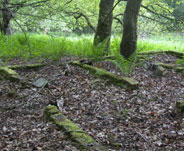 |
Woodland Ruin: This photograph of trees growing through the ruins of an old house, illustrates that ultimately nature will have the last word.
|
|
|
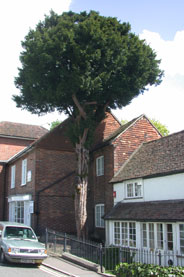 |
Westerham Yew
This impressive yew tree in Westerham, Kent, could well have been planted as an ornamental specimen in the front garden of these old cottages, or is it older and the houses were built around it? |
|
Considering Pruning
The first question, when considering pruning, is whether cutting off and removing living branches will actually benefit the tree? Will the proposed pruning prolong it’s useful life expectancy within the context of the surrounding environment and land use? It is important to remember that pruning may do more harm than good, and in some situations may create more problems than it solves. Why does the tree need pruning, in fact does it ‘need’ to be pruned?
Every cut made has the potential to change the growth characteristics of the tree. Removing living foliage, by pruning, affects the trees physiology and future productivity. The reduction in leaf area that results from pruning will reduce the tree’s overall photosynthetic capacity and may reduce overall growth on the pruned section, or the entire tree. Pruning can therefore have a lasting impact on the viability of the tree and can directly influence it’s longevity.
One of the major limitations of crown pruning is that it has a very one-sided impact on tree physiology. Before pruning the tree will be maintaining a natural equilibrium of growth, both in the crown of leaves and branches, and underground in it’s system of roots. Raw materials are absorbed from the soil, moved up through the transport system within the trunk and branches to the leaves, where energy is produced through photosynthesis. By removing leaves and branches from the crown the arborist disrupts the balance, forcing the tree into a state of turmoil. |
|
The casual observer of the growth that appears after pruning, could be mistaken for thinking that cutting off branches and reducing the tree’s leaf area, is beneficial and encourages new vigour. This may indeed appear to be the case, but it is essential to remember that severely pruned trees will initiate the production and growth of warersprouts, as a response to the need for new foliage to readdress the balance of photosynthetic capacity and energy requirements. To sustain this flush of growth the tree must draw on stored energy reserves, which limit the resources available to resist infection, disease and decay.
For arborists, charged with the responsibility of caring for trees, the primary pruning considerations, are those that affect the tree’s physiological condition, it’s ability to compete with pathogens and it’s durability within a wider ecological context. Pruning influences the trees physiological productivity: it’s ability to resist pathogens, it’s successful reproduction and it’s efficient use of natural resources, which ultimately impact on it’s sustainability and longevity. So, how often does the advice provided by arborists beneficial to the tree?
“Except during the nine months before he draws his first breath,
no man manages his affairs as well as a tree does.”
George Bernard Shaw |
| |
Looking beyond tree care.
In most cases the real motivations behind tree pruning are associated with the human values of visual aesthetics, amenity and recreation. This may be, in part at least, due to our need to see trees as being worth something, to have some purpose or function, which we can use. The notion of trees as ‘service providers’ was examined within a paper called ‘What are trees for?’ by Martin Spray, which was published in the Arboricultural Journal (September 2002, Vol.26 pp 263-279).
Primary considerations are all associated with the impact pruning will have on the tree, but if tree care is the drive behind pruning, how does the tree actually benefit? The answer is that more often that not the tree does not benefit, with the exception perhaps that formative pruning during the establishment stages, which can improve the structural form and stability of a tree’s trunk and branch growth. However, even this is a human interpretation of good structural form. Pruning must therefore, be considered within the context of understanding tree physiology over time, while taking into consideration the ecological impacts.
The point is that although the instigation behind tree pruning is associated and inextricably linked with human values, the implications have a direct impact on the physiology of the tree and the ecological balance within it’s environment. The arborist must, as a person responsible for tree care, work with a knowledge, understanding and respect for the arboreal ecosystem and not just the tree which happens to be the subject of the pruning specifications.
|
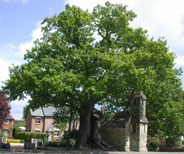 |
Lingfield Oak.
The engraving on the south face of the structure under this grand old oak tree, reads: “This cross was built circa 1473 to designate the boundaries of Puttenden and Billeshurst Manor. The Cage for the detention of petty offenders added in 1773 was last used in 1882 to detain poachers.” Was the tree used to mark the boundary before the cross was built? Was it used as a hanging tree? |
|
| |
This involves an appreciation of the ecological value of trees and perhaps an acknowledgement that they might have some intrinsic value, because they support a diverse arboreal ecosystem, which in turn contributes to the vast complex, that ultimately influence the world which we live in. Arboriculture as a profession has influence far beyond simply caring for trees, and there is a need to adopt an ecological consciousness which should incorporate a Code of Environmental Ethics. Quite simply it must be asked; is an arborist genuinely caring for trees without such a code?
“A thing is right when it tends to preserve the integrity, stability and beauty
of the biotic community. It is wrong when it tends otherwise.”
Aldo Leopold ‘Land Ethic’ 1949 |
|
| |
.jpg) |
-2.jpg) |
West Wickham Oak
This impressive ancient oak pollard, is growing in a rear garden of a suburban house in West Wickham, Kent. The tree is thought to be in the region of 600-700 years old. Residential houses now surround the tree, which has been swallowed by the urban sprawl of London’s 1930’s suburban development. The houses either side have been given planning permission by the local planning authority to build extensions, which have placed more pressure on the tree and the responsibilities of it’s owners. The neighbours now complain about the tree, which blocks light from their gardens and bedroom windows. |
|
A life time to understand
Trees are one of the few organisms which have an average life expectancy that exceeds our own (human) ‘three score years and ten’, yet we offer them very little respect for this achievement. In fact, trees figure so low on the day to day agenda of modern life that few people stop to consider their value. However, when someone actually pauses to think of the contribution trees make to their lives as an individual, or as a member of society, the list can appear endless.
There is a growing recognition that trees have a part to play, from the calming influence they have on our everyday lives to their ability to sequester carbon-dioxide which could influence the sustainability of human survival on the planet. Many of these beneficial attributes are linked to the slow progression of tree growth over their long life spans, which can frequently be measured in centuries. However, many trees are deprived of the opportunity to live out their natural lives, because of a human ignorance that inflicts it’s will on the world with an arrogance that fails to recognise that everything is intrinsically connected.
The technological advancement of human society has created populations of people who have lost track of their cultural connection with an area or community, to the extent that they shuffle around their country and sometimes the world, moving from place to place. Is it any surprise then, that the new owner of a suburban residence has no qualms with felling an oak tree, which may have been planted over 100 years ago during an era he/she feels no connection with?
The person who fells the 100 year old oak, fails to appreciate it’s value and considers that his/her rights, to live in a place without trees, are greater than the accumulative values and benefits of the one oak. However, the same person may only live in the property for no more than a decade, less than a tenth of the trees age. Which of the two has, earned or deserves, the greatest right to life?
“Generations pass while some trees stand, and old families last not three oaks.”
Sir Thomas Brown |
|
Learning the Compromise
In this over populated modern world there have to be compromises to maintain some degree of harmony, and if we are to life in association with trees the compromise is pruning. There is rarely space in our crowded towns, cities and even villages, for the mature size of trees. Some form of pruning has to be considered to readdress the balance, but just because they are perceived to be growing in the ‘wrong’ place, does that mean they have lost their value?
A tree may be deemed to require pruning because it is considered to be ‘too big’, a ‘hazard’ or simply growing in a location where it is at odds, or out of context, with the surrounding land use. However, there is no reason to ignore it’s potential life expectancy, and the ecological values associated with it. Pruning work must be completed with an understanding of the physiological limitations that impact on the tree’s ability to react to the loss of living foliage. Pruning is all about compromise!
The reactive capacity of a tree will be compromised to some degree, depending on the pruning techniques employed, and the volume of living wood and foliage which is removed at any one time. When making pruning decisions the arborist must consider the chronological age of the tree, because a tree in it’s formative years may be able to tolerate the loss of a large limb, but the same tree in full to late maturity might suffer terminally in similar circumstances.
An arborist who is responsible for large populations of trees, such as those owned and managed by local authorities or large parks and gardens, must guard against the use of generic pruning specifications which do not take the trees chronological age into consideration. It is also essential that the same arborist’s keep records of tree populations, and how they have been managed. Because during their working life, of up to 55 years, they may have influence for less than 25, which is a quarter of the life span of a 100 year old tree. “I resent the creation of a world in which beauty is a reminder of what we’re losing,
rather than a celebration of what we’ve got.”
Ben Elton |
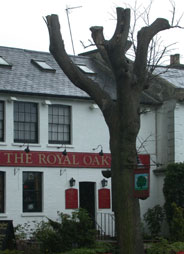 |
Royal / Sussex Oak
Where would you rather spend a sunny summers afternoon? |
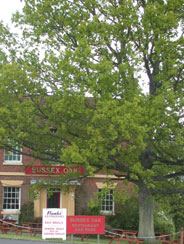 |
|
|
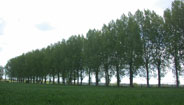 |
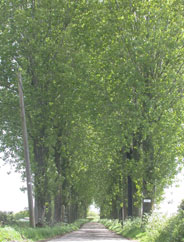 |
Poplar Avenue
This avenue of poplar trees lines the drive to an old country farmhouse in Kent. It was damaged badly in the storm of 1987 when several trees lost their tops. The pruning work to reinstate, involved topping all the trees, stripping them of branches and leaving them looking like two lines of telegraph poles. ‘Desperate times call for desperate measures’ as the saying goes, but it appears to have worked. The success may, be in part, due to the age of the trees, which were in their formative years and capable of tolerating the drastic pruning methods used. |
|
The natural balance of tree ecology It is well established now, through the work of researchers like Lonsdale, Schwarze, Boddy and Raynor that many plant pathogens co-exist for extended periods of time, in harmony with their host. Although the full significance of this has yet to be interpreted from the observational research completed to date. The concept that the organisms we consider to be pathogens (and therefore ‘bad’) make some positive contribution to the arboreal ecosystem, does not require a ‘leap of faith’ or great foresight. However, it is equally important that we do not jump to conclusions.
Thoughtless pruning can interfere with and interrupt the natural balance between symbiotic and parasitic relationships within the tree and associated arboreal ecosystems. The physiological, pathological and ecological impacts of pruning work will not be immediately apparent, because the tree will react through growth which occurs over a period of years.
A greater understanding and appreciation of the long life processes of trees is essential. An arborist responsible for the care of just one tree, can only hope to have an influence for a fraction of it’s potential life span. However the pruning decisions, that the arborist makes, can have a direct impact on the tree and it’s sustainable life expectancy. A decision made today could have consequences that are experienced decades and possibly centuries after.
Trees, as long lived organisms, are slow to react to changes in their environment. Our increasingly fast pace of life means that we can inflict change on our surroundings in quick succession. A tree, which may fall victim to this, will suffer stresses that could culminate in premature death.
“If we represent knowledge as a tree, we know that things that are divided
are yet connected.
We know that to observe the divisions and
ignore
the connections is to destroy the tree.”
- Wendell Berry - |
|
| |
SUMMARY
Over a period of time, it has become clear that humans are capable of actions that may enhance or detract from the quality of life. Humans have increasingly sought to detach themselves from their environment and frequently make decisions or perform acts which, that seemingly desirable in the short term or for humans specifically, have the capacity of damaging or destroying the life-support systems of the environment on which humans depend. [Blackmore, Keith (1997): Environmental Ethics. ~Trumpeter: 14,3 http://www.icaap.org ]
“People who will not sustain trees
will soon live in a world that will not sustain people.”
Bryce Nelson
back to top |
|
For
more info see:
Articles
Archive
Resources |
|
|
|
|